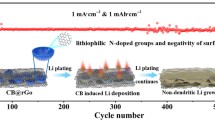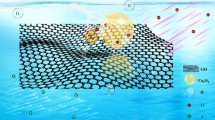Abstract
Lithium (Li) metal is promising for high energy density batteries due to its low electrochemical redox potential and high specific capacity. However, the formation of dendrites and its tendency for large volume expansion during plating/stripping restrict the application of Li metal in practical scenarios. In this work, we developed reduced graphene oxide-graphitic carbon nitride (rGO-C3N4, GCN) with highly elastic and wrinkled structure as the current collector. Lithiophilic site C3N4 in GCN could reduce the nucleation overpotential. In addition, this material effectively inhibited electrode expansion during cycling. At the same time, due to its high elasticity, GCN could release the stress induced by Li deposition to maintain structural integrity of the electrode. Li-metal anodes with GCN exhibited small volume expansion, high Coulombic efficiency (CE) of 98.6% within 300 cycles and long cycling life of more than 1700 h. This work described and demonstrated a new approach to construct flexible current collectors for stable lithium-metal anodes.

摘要
锂金属由于低电化学还原电位和高比容量, 被认为是最具发展前景的负极材料. 然而, 锂枝晶和体积膨胀等问题严重制约了锂金属电池的应用发展. 本研究中, 我们制备了高弹性波浪结构的 rGO-C3N4 (GCN)作为三维集流体. GCN的高弹性可有效释放锂沉 积过程产生的应力, 保持电极结构完整, 减小电极体积膨胀. C3N4 的亲锂性可降低锂的形核过电位, 促进锂离子均匀沉积. GCN作为三维集流体的锂金属负极, 经300个循环后, 仍具有较高的库仑效率, 低的体积膨胀率和更长的循环寿命. 高弹性波浪结构三维集流体改善了锂金属负极的电化学性能, 为构建柔性三维集流体提供了新思路.
Similar content being viewed by others
References
Lu Y, Zhang Q, Chen J. Recent progress on lithium-ion batteries with high electrochemical performance. Sci China Chem, 2019, 62: 533–548
Park S, Jin HJ, Yun YS. Advances in the design of 3D-structured electrode materials for lithium-metal anodes. Adv Mater, 2020, 32: 2002193
Lin D, Liu Y, Cui Y. Reviving the lithium metal anode for high-energy batteries. Nat Nanotech, 2017, 12: 194–206
Duan J, Zheng Y, Luo W, et al. Is graphite lithiophobic or lithiophilic? Natl Sci Rev, 2020, 7: 1208–1217
Nanda S, Gupta A, Manthiram A. Anode-free full cells: A pathway to high-energy density lithium-metal batteries. Adv Energy Mater, 2021, 11: 2000804
Li L, Li S, Lu Y. Suppression of dendritic lithium growth in lithium metal-based batteries. Chem Commun, 2018, 54: 6648–6661
Liu S, Xia X, Deng S, et al. Large-scale synthesis of high-quality lithium-graphite hybrid anodes for mass-controllable and cycling-stable lithium metal batteries. Energy Storage Mater, 2018, 15: 31–36
He D, Liao Y, Cheng Z, et al. Facile one-step vulcanization of copper foil towards stable Li metal anode. Sci China Mater, 2020, 63: 1663–1671
Zhang L, Yang T, Du C, et al. Lithium whisker growth and stress generation in an in situ atomic force microscope-environmental transmission electron microscope set-up. Nat Nanotechnol, 2020, 15: 94–98
Yu SH, Huang X, Brock JD, et al. Regulating key variables and visualizing lithium dendrite growth: An Operando X-ray study. J Am Chem Soc, 2019, 141: 8441–8449
Guo Y, Li H, Zhai T. Reviving lithium-metal anodes for next-generation high-energy batteries. Adv Mater, 2017, 29: 1700007
Wu S, Zhang Z, Lan M, et al. Lithiophilic Cu-CuO-Ni hybrid structure: Advanced current collectors toward stable lithium metal anodes. Adv Mater, 2018, 30: 1705830
Chen Y, Ke X, Cheng Y, et al. Boosting the electrochemical performance of 3D composite lithium metal anodes through synergistic structure and interface engineering. Energy Storage Mater, 2020, 26: 56–64
Wu H, Zhang Y, Deng Y, et al. A lightweight carbon nanofiber-based 3D structured matrix with high nitrogen-doping level for lithium metal anodes. Sci China Mater, 2019, 62: 87–94
Wu W, Duan J, Wen J, et al. A writable lithium metal ink. Sci China Chem, 2020, 63: 1483–1489
Shen Z, Zhang W, Li S, et al. Tuning the interfacial electronic conductivity by artificial electron tunneling barriers for practical lithium metal batteries. Nano Lett, 2020, 20: 6606–6613
Chen J, Zhao J, Lei L, et al. Dynamic intelligent Cu current collectors for ultrastable lithium metal anodes. Nano Lett, 2020, 20: 3403–3410
Luo Y, Li T, Zhang H, et al. New insights into the formation of silicon-oxygen layer on lithium metal anode via in situ reaction with tetraethoxysilane. J Energy Chem, 2021, 56: 14–22
Han Y, Zhou Y, Zhu J, et al. Dual effects from in-situ polymerized gel electrolyte and boric acid for ultra-long cycle-life Li metal batteries. Sci China Mater, 2020, 63: 2344–2350
Guan X, Wang A, Liu S, et al. Controlling nucleation in lithium metal anodes. Small, 2018, 14: 1801423
Biswal P, Stalin S, Kludze A, et al. Nucleation and early stage growth of Li electrodeposits. Nano Lett, 2019, 19: 8191–8200
Wu K, Zhao B, Yang C, et al. ZnCo2O4/ZnO induced lithium deposition in multi-scaled carbon/nickel frameworks for dendrite-free lithium metal anode. J Energy Chem, 2020, 43: 16–23
Lin D, Liu Y, Liang Z, et al. Layered reduced graphene oxide with nanoscale interlayer gaps as a stable host for lithium metal anodes. Nat Nanotech, 2016, 11: 626–632
Zhou Y, Zhang X, Ding Y, et al. Redistributing Li-ion flux by parallelly aligned holey nanosheets for dendrite-free Li metal anodes. Adv Mater, 2020, 32: 2003920
Ye H, Zheng ZJ, Yao HR, et al. Guiding uniform Li plating/stripping through lithium-aluminum alloying medium for long-life Li metal batteries. Angew Chem Int Ed, 2019, 58: 1094–1099
Chen X, Chen XR, Hou TZ, et al. Lithiophilicity chemistry of heteroatom-doped carbon to guide uniform lithium nucleation in lithium metal anodes. Sci Adv, 2019, 5: eaau7728
Chen J, Wen L, Liang J, et al. Tunable in situ stress and spontaneous microwrinkling of multiscale heterostructures. J Phys Chem C, 2019, 123: 26041–26046
Ding F, Xu W, Graff GL, et al. Dendrite-free lithium deposition via self-healing electrostatic shield mechanism. J Am Chem Soc, 2013, 135: 4450–4456
Wang X, Zeng W, Hong L, et al. Stress-driven lithium dendrite growth mechanism and dendrite mitigation by electroplating on soft substrates. Nat Energy, 2018, 3: 227–235
Huang Y, Chen B, Duan J, et al. Graphitic carbon nitride (g-C3N4): An interface enabler for solid-state lithium metal batteries. Angew Chem Int Ed, 2020, 59: 3699–3704
Ye S, Wang L, Liu F, et al. g-C3N4 derivative artificial organic/inorganic composite solid electrolyte interphase layer for stable lithium metal anode. Adv Energy Mater, 2020, 10: 2002647
Lu Z, Liang Q, Wang B, et al. Graphitic carbon nitride induced micro-electric field for dendrite-free lithium metal anodes. Adv Energy Mater, 2019, 9: 1803186
Kessler FK, Zheng Y, Schwarz D, et al. Functional carbon nitride materials—design strategies for electrochemical devices. Nat Rev Mater, 2017, 2: 17030
Guo Y, Niu P, Liu Y, et al. An autotransferable g-C3N4Li+-modulating layer toward stable lithium anodes. Adv Mater, 2019, 31: 1900342
Xu X, Zhang Q, Yu Y, et al. Naturally dried graphene aerogels with superelasticity and tunable Poisson’s ratio. Adv Mater, 2016, 28: 9223–9230
Wu Y, Yi N, Huang L, et al. Three-dimensionally bonded spongy graphene material with super compressive elasticity and near-zero Poisson’s ratio. Nat Commun, 2015, 6: 6141
Hu H, Zhao Z, Wan W, et al. Ultralight and highly compressible graphene aerogels. Adv Mater, 2013, 25: 2219–2223
Zhao Y, Feng J, Liu X, et al. Self-adaptive strain-relaxation optimization for high-energy lithium storage material through crumpling of graphene. Nat Commun, 2014, 5: 4565
Deng S, Berry V. Wrinkled, rippled and crumpled graphene: An overview of formation mechanism, electronic properties, and applications. Mater Today, 2016, 19: 197–212
Pan L, Luo Z, Zhang Y, et al. Seed-free selective deposition of lithium metal into tough graphene framework for stable lithium metal anode. ACS Appl Mater Interfaces, 2019, 11: 44383–44389
Song Q, Yan H, Liu K, et al. Vertically grown edge-rich graphene nanosheets for spatial control of Li nucleation. Adv Energy Mater, 2018, 8: 1800564
Zhang R, Chen XR, Chen X, et al. Lithiophilic sites in doped graphene guide uniform lithium nucleation for dendrite-free lithium metal anodes. Angew Chem Int Ed, 2017, 56: 7764–7768
Wang H, Li Y, Li Y, et al. Wrinkled graphene cages as hosts for high-capacity Li metal anodes shown by cryogenic electron microscopy. Nano Lett, 2019, 19: 1326–1335
Yang G, Chen J, Xiao P, et al. Graphene anchored on Cu foam as a lithiophilic 3D current collector for a stable and dendrite-free lithium metal anode. J Mater Chem A, 2018, 6: 9899–9905
Huang S, Yang H, Hu J, et al. Early lithium plating behavior in confined nanospace of 3D lithiophilic carbon matrix for stable solid-state lithium metal batteries. Small, 2019, 15: 1904216
Zhu W, Deng W, Zhao F, et al. Graphene network nested Cu foam for reducing size of lithium metal towards stable metallic lithium anode. Energy Storage Mater, 2019, 21: 107–114
Wang T, Zhai P, Legut D, et al. S-doped graphene-regional nucleation mechanism for dendrite-free lithium metal anodes. Adv Energy Mater, 2019, 9: 1804000
Li BQ, Chen XR, Chen X, et al. Favorable lithium nucleation on lithiophilic framework porphyrin for dendrite-free lithium metal anodes. Research, 2019, 2019: 1–11
Zhang R, Wen S, Wang N, et al. N-doped graphene modified 3D porous Cu current collector toward microscale homogeneous Li deposition for Li metal anodes. Adv Energy Mater, 2018, 8: 1800914
Wang X, Pan Z, Wu Y, et al. Reducing lithium deposition overpotential with silver nanocrystals anchored on graphene aerogel. Nanoscale, 2018, 10: 16562–16567
Nie X, Zhang A, Liu Y, et al. Synthesis of interconnected graphene framework with two-dimensional protective layers for stable lithium metal anodes. Energy Storage Mater, 2019, 17: 341–348
Acknowledgements
This work was supported by the National Natural Science Foundation of China (51525206 and 51927803), the National Key R&D Program of China (2016YFA0200100 and 2016YFB0100100), the Strategic Priority Research Program of the Chinese Academy of Sciences (XDA22010602), Liaoning Revitalization Talents Program (XLYC1908015), and China Petrochemical Cooperation (218025). The authors thank Mrs. Juan Li and Mr. Bo Wen for their valuable discussion.
Author information
Authors and Affiliations
Contributions
Author contributions Lu W prepared and characterized the samples. Chen J performed mechanical tests. Lu W, Yang H, and Sun C analyzed experimental data and prepared the manuscript. Li F supervised the project and revised the manuscript. All authors contributed to the general discussion.
Corresponding author
Ethics declarations
Conflict of interest The authors declare that they have no conflict of interest.
Additional information
Wenwen Lu is a master’s candidate at the Institute of Metal Research, Chinese Academy of Sciences (IMR, CAS). Her research interests include the syntheses and characterizations of 3D current collectors for lithium-metal anodes.
Feng Li is a professor of IMR, CAS. He received his PhD degree in materials science at IMR, CAS in 2001 supervised by Prof. Hui-Ming Cheng. He mainly works on the novel carbon-based and energy materials for lithium-ion batteries, lithium-sulfur batteries, electrochemical capacitors, and new devices. He obtained the award of the National Science Fund for Distinguished Young Scholars by the National Natural Science Foundation of China.
Electronic supplementary material
Rights and permissions
About this article
Cite this article
Lu, W., Yang, H., Chen, J. et al. Highly elastic wrinkled structures for stable and low volume-expansion lithium-metal anodes. Sci. China Mater. 64, 2675–2682 (2021). https://doi.org/10.1007/s40843-021-1676-3
Received:
Accepted:
Published:
Issue Date:
DOI: https://doi.org/10.1007/s40843-021-1676-3




